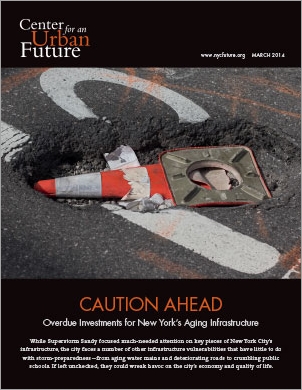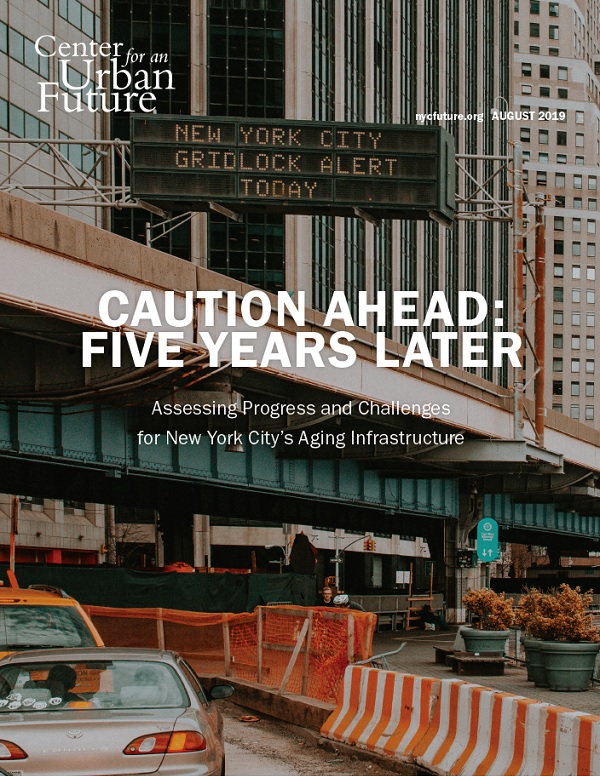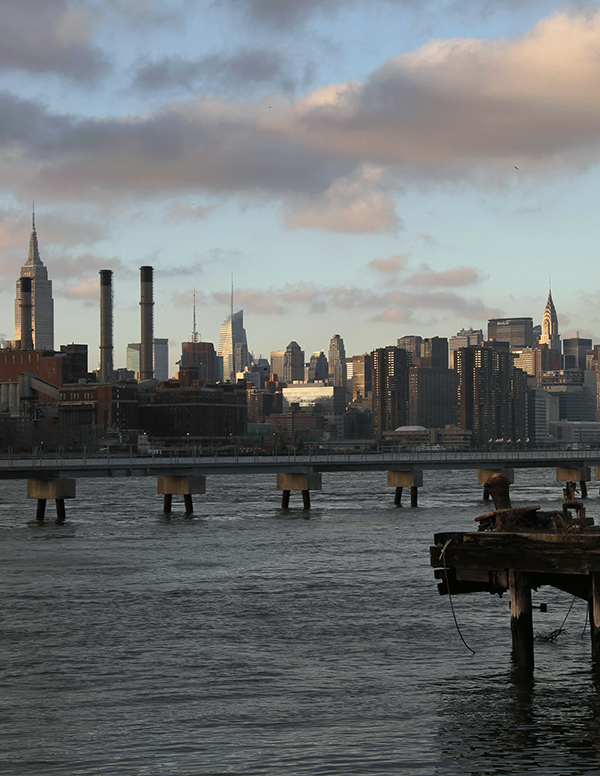Bringing Down Infrastructure Costs
Authorize Design-Build and public-private partnerships
In 2011, at Governor Cuomo’s initiative, the legislature authorized a handful of state agencies to pursue Design-Build contracts, but excluded municipalities. The law is set to expire at the end of 2014. Given the results to date, including the positive impact this approach had on the projected cost of replacing the Tappan Zee Bridge and in expediting the reconstruction of major upstate roads severely damaged by Hurricane Irene, the state should renew the legislation, but also expand its scope beyond horizontal infrastructure (such as roads and bridges), authorize both Design-Build and Design-Build-Operate-Maintain contracts and allow municipalities to participate. Streamlined procurement could reduce costs and shorten delivery time frames. New York City’s procurement process and the long-term quality of its infrastructure would be significantly improved.
Avoid “Low Bids” from unqualified contractors
Construction delays and cost overruns are often traced to inexperienced contractors who fail to live up to their “low bid.” In 2009, Albany authorized cities to pre-qualify public works contractors based on credentials, experience and past performance, thus ensuring that selected contractors are capable of providing quality construction. While the DDC, HPD, DOT and DoITT have begun to implement pre-qualification lists for select contracts, thus far the emphasis has been on reducing the length of the procurement process. Moving forward, pre-qualification lists should be used for more complex projects with a focus on screening out unqualified candidates incapable of honoring their “low bid.”
“Low bids” also become inflated when they underestimate the cost of relocating underground utilities for a project. To avoid these oversights, the State Legislature authorized “joint-bidding” in Lower Manhattan. This practice requires bidders to provide separate prices for municipal and private utility work, with the contract awarded to the lowest responsible bidder for the combined work. Utility companies, by separate agreement, reimburse the City for additional costs if the low bidder on the municipal work is not the same as the low bidder on the combined work. To avoid cost overruns and delays, these provisions should be extended to the rest of the city.
Reduce the time to design and approve construction contracts
As they develop new sources of funding, city and state officials should also take immediate steps to address the high cost of building. The cost of construction is extremely high across the board in New York City, but public projects are in a league of their own. They take much longer to complete and cost consistently more than similar work in the private sector. The city could start by reducing the time it takes to design and approve construction contracts, particularly for smaller projects and those with a history of on-time and on-budget construction. For any project over $25,000, agencies typically need approvals from the Office of Management and Budget, the City Comptroller, the Law Department, the Department of Finance and the Mayor’s Office of Contract Services. This exhaustive process can last anywhere from 162 days to two years. Introducing procurement software that allows agencies to simultaneously, rather than sequentially, review proposals could expedite approval. The city’s Environmental Quality Review process is another source of expensive delays that could be avoided if the city adopted time limits on reviews similar to those at the state level.
Renew Project Labor Agreements
The city should renew project labor agreements (PLAs), which are due to expire on June 30, 2014. These PLAs provide labor-cost certainty and exempt the city from the state’s Wicks Law, a cumbersome and expensive regulation that requires agencies to issue separate contracts for plumbing, electric and HVAC on any construction project exceeding $3 million.
Repeal the Scaffold Law
Albany elected officials should repeal the nation’s last remaining “Scaffold Law,” which significantly inflates insurance costs compared to other states. The Scaffold Law holds builders responsible for “elevation related” injuries regardless of fault. Determining compensation based on comparative liability, as is done in most other states across the country, could save agencies like the School Construction Authority tens of millions of dollars in insurance premiums every year.
Improving Infrastructure Planning
Create a more effective capital planning process
With at least $34.2 billion in unfunded infrastructure needs, New York will have to make intelligent choices about which projects to fund and which can be delayed. To do that effectively, the de Blasio administration should invest in a more accurate and complete survey of the city’s state of good repair needs and commit to funding future projects based on explicit and rigorous social and economic goals rather than historical precedent. It also should go beyond OMB and involve planning and economic development agencies to a greater extent than has been the case. The administration might draw lessons from the MTA and Port Authority. The MTA has significantly reformed its asset management strategy in recent years, favoring component rather than full systems replacement and introducing sophisticated cost, risk, performance and resource analysis through the new Strategic Assets Lifecycle Value Optimization program. The Port Authority too has refined its capital planning using a “comprehensive planning process and risk-based prioritization that considered asset condition, operational and revenue impact, threat assessment, customer service, regional benefit, and regulatory or statutory requirements.”
Establish a more accurate and thorough survey of the city’s infrastructure assets and their state of good repair
Each year, the Office of Management and Budget (OMB) releases the Asset Information Management System (AIMS) report surveying city-owned buildings, parks, bridges and piers and detailing the investment needs of individual city assets. The inspections are incomplete and the report cursory. It excludes the city’s water and sewer systems, public housing and East River bridges, among other things. It also overlooks handicap accessibility, asbestos abatement and modernization measures. Those assets that are surveyed are subject to only visual inspections, without any probing or specialized equipment.
High-quality capital planning depends on a high-quality assessment of conditions. This is especially important for smaller agencies, which cannot afford rigorous inspections by private consultants. Assessment data should be open to the public, allowing residents to track the city’s progress toward state of good repair, identify funding gaps and recommend more effective capital investment management strategies.
Better align infrastructure investments with economic development goals
When individual agencies and authorities develop their capital plans they don’t normally consider the city or state’s broader economic development goals. The MTA’s projected investment in a new train storage facility in Long Island City, for example, is based largely on the operational needs of the agency, not the development opportunities of the surrounding business district and neighborhood. Other cities and states have begun to invest in initiatives that better align these otherwise distinct spheres of deliberation and planning. The Oregon Business Plan initiative, for example, has led to strategic investments in bridges and transit infrastructure as a part of a broader plan to increase exports. Unlike a citywide capital plan or attempts to align capital plans across different agencies and authorities, this approach has the benefit of linking specific infrastructure projects with human capital investments to achieve important and measurable economic goals.
Take a census of underground utilities
In 2010, the MTA inspector general investigated cost overruns on the Second Avenue Subway and found that the discovery and rerouting of public utility lines drove up costs by more than $80 million and delayed the line’s completion by at least six months. To prevent future confusion and construction delays, New York needs to take a citywide census of public utility lines. The technology to perform this survey is already available. Con Edison experimented with Ground Penetrating Radar (GPR) around the World Trade Center site and along 149th Street and Southern Boulevard in the Bronx, discovering old trolley tracks running along high-voltage transmission lines. Because the radar is expensive, there should be a central repository of images, allowing public and private entities to pool their findings to assemble a comprehensive map.
Developing Infrastructure Innovations
Expand the MTA’s Small Business Mentoring Program
Beyond funding and track access, the greatest impediment to updating MTA’s signal system is the dearth of qualified contractors. Only three to four contractors are qualified to install and modernize signals. This limits competition, increases expenses and caps the amount of signal replacement that can be performed at any one time. To address this, the MTA recently began a small business mentoring program for training contractors. It should expand this program.
Invest in real-time bridge sensor technologies
Every year, New York City bridges are thoroughly inspected and assessed. Their condition ratings alert the city Department of Transportation to the most distressed bridges, helping them prioritize capital and maintenance needs for the coming years. While these inspections are known for their rigor, they are also time-consuming, expensive and inherently limited, relying on visual inspections that often identify problems only after internal cracking has occurred and rebar corrosion has begun. Oregon is piloting a real-time bridge sensor program. The sensors monitor temperature and moisture, collect chloride concentrations at multiple depths within the concrete and assess corrosion. New York’s city and state departments of transportation should invest in these technologies as well.
Lease space on city street lights, traffic signals and pay phones for telecom company cell sites
New Yorkers in every borough are hampered by patchy cell service and slow mobile broadband. In the city’s dense neighborhoods, signals often are blocked by buildings, water and reflective glass. To circumvent these physical barriers, telecom companies are shifting to “small cell technology,” opting for cell sites close to street level rather than macro towers on top of buildings. Companies like Verizon are considering all available locations, including payphones, streetlights and traffic lights. The city should rent these spaces to telecom providers, tapping into a new source of income while improving cell service. The new revenue source could be dedicated to the Economic Development Corp.’s ConnectNYC program, which provides fiber internet connectivity in commercial districts.
Reassign agency tech engineers to DoITT
In October 2010, Mayor Bloomberg issued Executive Order 140, a plan to consolidate the city’s outmoded and fractured IT systems. The Department of Information Technology and Telecommunications (DoITT) would assume control of data storage, application hosting, procurement and technology policy. Thus far, progress has been slow. City agencies have been reluctant to relinquish control over their tech operations, foregoing efficiency gains from centralized procurement and storage. To expedite this process, technical employees responsible for infrastructure in individual agencies should be reassigned to DoITT. There they would work on modernizing and integrating the city’s old and fragile information technology systems. Such an ambitious effort to overhaul tech infrastructure could attract young engineers to replace those currently maintaining legacy systems who are nearing retirement.
These were the recommendations in Caution Ahead. Click here to read the full report (PDF).







